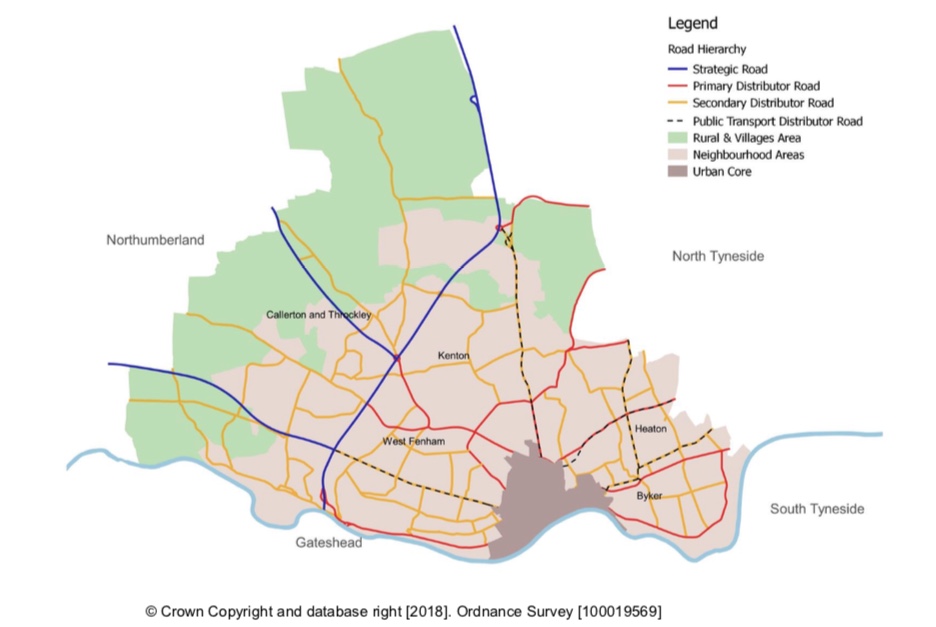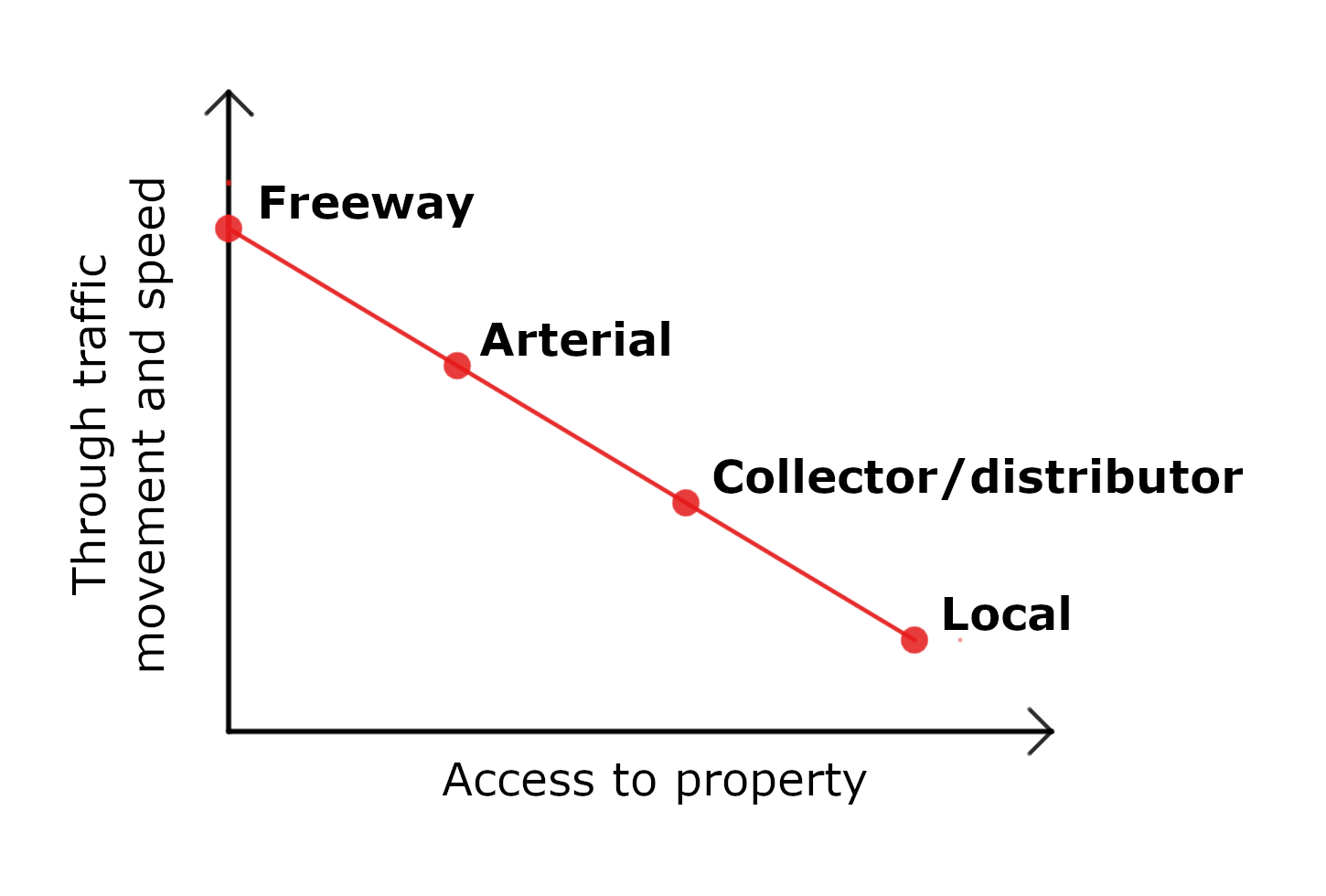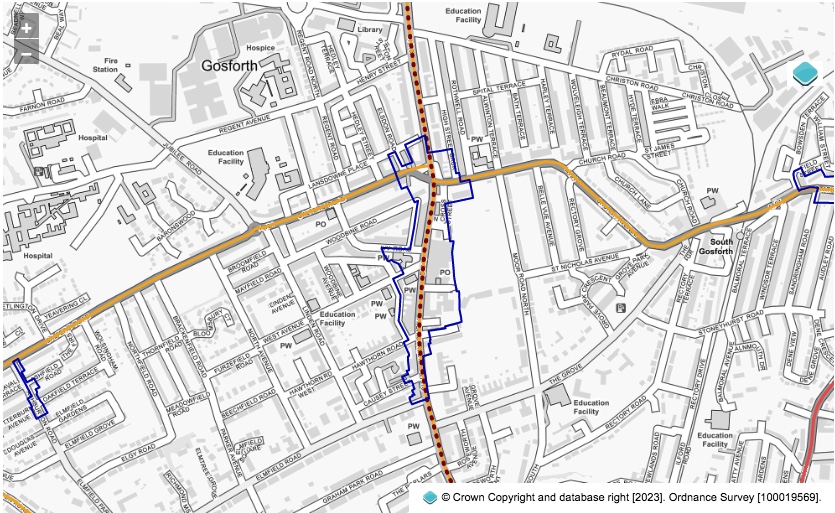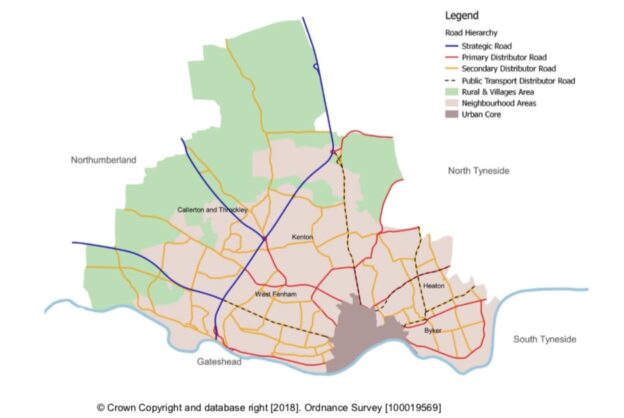
Everyone is familiar with A roads, B roads and Motorways, the national road classification that determines how roads are designed and how they are used. Newcastle also has its own local road classification, which we explain in this blog.
What are road classifications for?
Road classifications are used throughout the world as a way of specifying what roads are used for and therefore how they should be designed. They range from long distance high-capacity fast routes like motorways (freeways in the diagram below) that are designed for vehicles to travel safely at high speeds, to low-volume local streets designed mainly for access where vehicles are expected to travel slowly and where people should feel safe to walk and cycle without the need for special engineering measures.
The phrase Place vs Movement is often used to distinguish between streets that are important for people to meet, shop and socialise vs roads that are used for the movement of people, goods and services, which could be by car, bus, bike, van/lorry or walking.

By Belbury – Own work, CC BY-SA 4.0, https://commons.wikimedia.org/w/index.php?curid=128590751
DfT guidance states that “roads classification is intended to direct motorists towards the most suitable routes for reaching their destination. It does this by identifying roads that are best suited for traffic.”
From a safety perspective, it is important to get vehicles away from local unclassified roads and onto the main road network as soon as possible as the injury rate per vehicle mile driven is much higher on minor roads than on main routes.
Newcastle’s road hierarchy
Newcastle’s road hierarchy is made up of Strategic Routes, Primary and Secondary Distributors, Public Transport Distributors and other non-classified local roads. These were specified and consulted on as part of the city’s Development and Allocations Plan (DAP) in 2018.
DAP Policy DM13 states the purpose to of the hierarchy is to “support the management of movement on the highway network and to ensure the safe and efficient movement of people and goods.”
These are the full definitions.
| Category | Characteristics |
| Strategic Road | Nationally significant roads [manage by National Highways] used for the distribution of goods and services, and a network for the travelling public. |
| Primary Distributor Road |
|
| Secondary Distributor Road |
|
| Public Transport Distributor Road |
Public Transport Distributor Road can be classed as either primary or secondary distributor roads. They are based on existing key bus corridors into the Urban Core and experience some of the highest bus flows in Newcastle. They service residential, retail and public services within Newcastle and surrounding authorities. Defining Public Transport Distributor Roads reflects the emphasis on bus priority along these routes. |
To come up with these classifications Newcastle City Council produced a Road Hierarchy Justification Report, which was shared as part of the DAP consultation.
Which roads are which?
The map below shows which roads in Newcastle are strategic and which are primary/secondary/public transport distributors. All other roads are unclassified.

Map of Newcastle showing the local Road Hierarchy
Newcastle City Council has created an online Planning Policies Map that can be zoomed and scrolled and also shows other local policies relating to transport and other areas like housing and nature conservation.
In the Gosforth area, these are how main roads are split by category.
| Category | Examples roads from each category |
| Strategic Road | A1, A696, A69 |
| Primary Distributor Road | A189 (Grandstand Road, Jesmond Dene Road, Haddricks Mill Road, Matthew Bank, Killingworth Road ), A191 (Benton Park Road), B1318 (Great North Road south of Blue House roundabout), Central Motorway |
| Secondary Distributor Road | B1318 (Gosforth High Street, Great North Road north of Blue House roundabout), Kenton Road, A191 (Kenton Lane, Salters Road, Church Road, Church Avenue, Station Road), Kingston Park Road, Broadway West, Osborne Road, Freeman Road |
| Public Transport Distributor Road | B1318 (Gosforth High Street, Great North Road) |
Managing Conflicting Needs
Nearly all roads have some elements of both Place and Movement. The Newcastle Road Hierarchy, like all road hierarchies, is intended to manage these conflicting needs to keep people safe and balance the needs of all users.
- Strategic Routes enable the fast movement of traffic, managing risks by banning right turns and, in the case of motorways, by banning people walking and cycling.
- Primary and Secondary Distributors mitigate the risk posed to people from vehicle traffic using engineering interventions to separate people from traffic including formal crossings, pavements and protected cycle lanes. Traffic lights are also used to manage conflicting vehicle traffic flows.
- Local unclassified routes generally don’t have these engineering mitigations, so must have lower speed limits and lower volumes of traffic to be safe.
Just as people walking and cycling are banned from some Strategic Routes, the DAP contains a specific intention to discourage through traffic on unclassified roads.
“The road hierarchy, as set out in Policy DM13, can also discourage through traffic, whilst maintaining local access for residents and businesses. This creates opportunities, particularly in those areas not included in the hierarchy, to improve conditions for pedestrians and cyclists, and create welcoming places that are safe and attractive to all.”
Local Neighbourhoods
As well as creating welcoming places, reducing traffic on unclassified local streets also contributes to decarbonisation of the transport network as well as “significantly reducing accidents, noise, and air pollution for local residents”.

Image from the Government’s 2021 Transport Decarbonisation Strategy
Currently, streets like Linden Road, Elmfield Road, The Grove, Regent Road, Moor Road North and South and Regent Farm Road are busy because they are used by non-local through traffic to avoid traffic queues on main roads. According to Government guidance, anything over 2,000 vehicles a day on a 20mph street will start to exclude some road users due to safety concerns.
This undermines the road hierarchy as, being unclassified, these streets neither have the investment nor traffic management to safely cope with higher volumes of traffic. Either they need to be redesigned as secondary distributors with controlled crossings and protected cycle lanes, or (SPACE for Gosforth’s preference) have modal filters installed to reduce traffic levels and ensure through traffic remains on roads that are properly designed for that purpose in line with DfT guidance.
Gosforth High Street
One thing not recognised in the Newcastle road hierarchy, which SPACE for Gosforth asked to be added, is consideration of where main roads are also local destinations. Gosforth High Street, for example, is recognised on the policy map as a District Centre (outlined in blue in the map below) but only in the section of the DAP relating to retail.

Map of Gosforth showing the boundary of Gosforth District Centre
Retail destinations that are also on main roads present some of the greatest challenges for managing the conflict between Movement and Place. The SPACE for Gosforth view is that in this short section of road Gosforth High Street’s role as a local shopping street and community hub should take precedence over its role for moving people, goods and services.
The current trial bus-priority layout prioritises Movement over Place, prioritises journey times over safety, and does little for the High Street itself. If you want to feed back to the Council on this trial layout you can do so at https://gosforthhighstreet.commonplace.is. The formal six month consultation period ends 21 September 2023.

